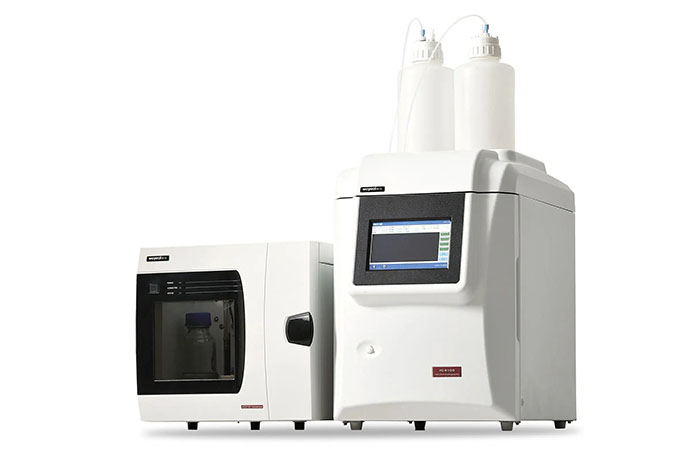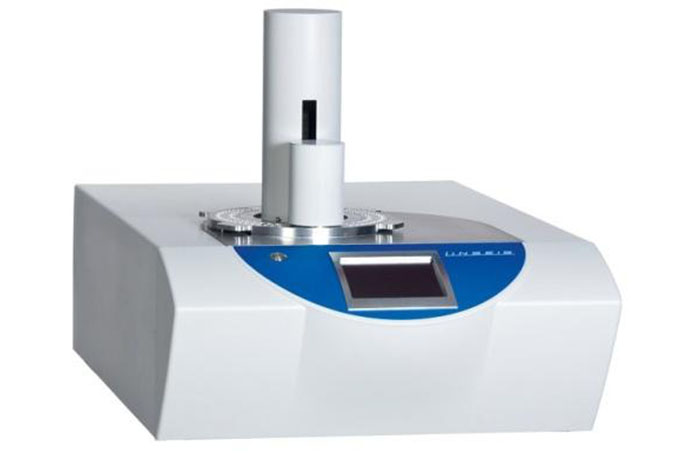How an ion chromatograph works
Although there are different types of ion chromatographs, their construction consists of five parts: a pump, sample injection system, chromatographic separation column, detector, and data processing. Ion chromatographs make full use of stationary-phase-mobile-phase exchange. Dissociable ions on the stationary phase ion exchange resin and solute ions in the mobile phase have distinct column residence periods. Solute-exchanger affinity is separated.
What are the classifications of ion chromatographs?
Ion chromatography has three main types: exchange, exclusion, and pair.
1) Ion exchange chromatography: uses differing tensions between ions to separate organic and inorganic anions and cations.
2) Ion Exclusion chromatography: uses Donnan row repulsion to separate solutes and stationary phases. It separates weak organic acids, alcohols, aldehydes, amino acids, and sugars.
3) Ion-pair chromatography: Ion-pair chromatography’s separation technique depends on the mobile phase’s selectivity. This approach separates surface-active anions, cations, and metal complexes.
Ion chromatography vs. high performance liquid chromatography
Ion chromatograph detects ions. It is classified according to the chromatographic principle. Ion liquid chromatography. Due to differences in structure and analytical items, ion chromatography is considered a separate instrument. Consider chromatography. Ion chromatography and HPLC differ in instrument structure and application.
1) The structure of the instrument
Both ion and high-performance liquid chromatography have solvent delivery, sample injection, detection, and signal recording and processing systems. Due to distinct mobile phases, ion chromatography and HPLC have various detection methods and signal processing. Parts vary.
1. Ion chromatography uses an aqueous solution of acid, alkali, and salt as the mobile phase. The system must be acid-and alkali-resistant. Ion chromatography devices use non-metallic materials. Polyetheretherketone (PEEK) plastic is used for pump bodies, flow paths, valve bodies, and other high-pressure parts. PTFE or PEEK is utilized for detectors, external pipelines, etc. Due to differences in how they are made and how strong they are, the compressive strength and precision of all plastics are lower than those of metals.
High performance liquid chromatography uses organic solvents as eluents, hence most use metal pump bodies, which are robust to organic solvents but corrode in acidic or basic mobile phases. Some high-performance liquid chromatography devices used in biology use PEEK as the pump body, flow channel, and valve to avoid metal adsorption on biologically active chemicals. Ion chromatography and HPLC are versatile in this sector.
2. Suppressed and non-suppressed ion chromatography exist. Nowadays, suppressed ion chromatography is common. No device exists for HPLC. Suppressors are comparable to HPLC post-column derivatization devices but are used in SIC. Unsuppressed ion chromatography uses no suppressor, like HPLC. Unsuppressed ion chromatography uses high-performance pumps, flow channels, and injection valves.
3. Ion chromatography and HPLC use different detectors. Ion chromatography utilizes a conductivity detector while HPLC uses a UV-visible photometric detector.
2) Analyze
High performance liquid chromatography is a popular analytical device. High performance liquid chromatography generally analyzes organic chemicals since the analyte must have a specified photometric absorbance. Ion chromatography looks at inorganic ions by using the conductivity created when ions in an aqueous solution break apart.
Ion chromatography is commonly used to analyze organic substances, and HPLC may analyze inorganic ions. Complementary separation modes Ion chromatography can solve analytical difficulties HPLC can’t.
FAQ:
What detectors does an ion chromatograph have?
In ion chromatography, the conductance detector is the most basic and most commonly used detector. The amperometric detector comes in second.
1) Conductivity detector
Conductivity detectors are based on limiting molar conductivity and are mostly used to find anions and cations in inorganic matter, as well as organic acids and amines.
a) Bipolar Pulse Detector: Two electrodes are put on the flow path, and a pulsed voltage is used to measure the current at the right time so that it can be enlarged and shown and able to get polarized electrodes and electric double layers.
b) Quadrupole Conductivity Detector: Four electrodes are placed on the flow path, and the voltage between the two measurement electrodes is kept constant by the circuit design. This type of conductivity detector is not affected by changes in load resistance, inter-electrode resistance, or electric double layer capacitance. It also has an electronic suppression function (cation detection supports direct conductance detection mode).
c) Pentapole Conductivity Detector: A grounded shield electrode is added to the quadrupole conductance detection mode. This greatly improves the measurement stability and makes it possible to get very low noise even when the background conductance is high.
2) Ampere meter
Amperometric detectors work by measuring how strong an electrolytic current is. They are mostly used to find things that have redox properties.
a) DC amperometric detection mode: this is mostly used to find ascorbic acid, bromine, iodine, cyanide, phenol, sulfide, sulfite, catecholamine, aromatic nitro compounds, aromatic amines, uric acid, and p-diphenol.
b) Pulse amperometric detection mode: mostly used to find alcohols, aldehydes, sugars, amines (mono-ditriamines, which include amino acids), organic sulfur, thiols, thioethers, and thioureas. Sulfur oxides are not detectable.
c) Integral pulse ampere detection mode: This mode is an improved version of pulse ampere detection. It can be used to find substances that pulse ampere detection can find.
Why does the pressure in the ion chromatograph system keep going up?
Most of the time, the ion chromatograph has a high-pressure limit pressure range of about 15 MP. When the equipment’s pressure reaches the high-pressure limit, it will shut itself off. When the pressure is more than 30% above the normal pressure, the pressure is considered to be abnormal. This is usually caused by one of the following things.
- When an organic solvent is mixed with water, the viscosity of the solution makes the density change pressure go up.
- If a section of a pipe is blocked, the system pressure goes up quickly.
- When the flow rate exceeds 0.7 mL/min above the normal pressure, the pressure rises.
Why is the ion chromatograph system pressure reduced?
Leakage causes the ion chromatograph’s pressure to drop. Check the ion chromatograph’s joints now. Please tighten loose screws. When there are many air bubbles in the system flow channel, cavities occur in the pump, reducing system pressure. Stop the pump by unscrewing its screw. Remove air bubbles using a syringe, then restart the pump.
How should liquid samples from an ion chromatograph be handled?
There are two main types of methods for pre-treatment of liquid samples before the ion chromatograph works:
1) Micro-membrane filtration
a) Membrane or sand core treatment: In-line processing can be done with sand cores. There will be a small number of ions that will mess up the experiment, so for trace ion analysis, you need to do multiple washes and subtract the blank background.
b) Electrodialysis treatment method: The method can also be used to get rid of heavy metal ions, in addition to particulate matter and organic pollutants.
c) Electrolysis method of neutralization: With this method, trace anions and cations in high concentrations of acids and bases can be fully analyzed.
2) Solids extraction method
a) Ion-swapping resins: Different types of resins make it possible to remove contaminants in a targeted way.
b) The reversed-phase and adsorption solid-phase extraction methods: This method can be used to find transition metals and lanthanide metals that are hard to find.
The ion chromatograph system has big changes in pressure and a rough flow.
Air has gotten into the system, or there is something solid between the gem ball and the valve seat of the one-way valve, making it impossible to close and seal. To clean the one-way valve with sonic waves, you have to take it off and put it in a beaker with ethanol. When the pressure sensor on the analysis pump is broken, the pressure will also go up and down. Check to see if the sensor knob’s O-ring is worn.
What can an ion chromatograph do, and what can be tested and analyzed with it?
Ion chromatography is used to analyze anions and cations in surface water, drinking water, rainwater, sewage, industrial effluent, acid sediments, and air particles. Anions like F-, Cl-, Br-, NO2-, PO43-, NO3-, SO42-, formic acid, acetic acid, oxalic acid, etc. are common ions that can be found. Li+, Na+, NH4+, K+, Ca2+, Mg2+, Cu2+, n2+, Fe2+, Fe3+, etc., are cations.
What do the injectors of an ion chromatograph do?
There are many different kinds of injectors, and they can handle high pressure, resist corrosion, be used over and over again, and be easy to use. Automatic injectors, pneumatic injectors, and six-way valve injectors are often used for ion chromatographs.
1) Autosampler
A highly automated, software-controlled system performs sample loading, injection, and cleaning. The operator simply needs to insert the samples into the storage machine in sequence. Autosamplers are very expensive, and most of the time, they come with good instruments.
2) Pneumatic injector
This injector is very good. It employs nitrogen pressure as power and loads and injects samples through a two-way or four-way quantitative tube, reducing manual injection variation. The problem is that you have to use nitrogen cylinders, which is not ideal.
3) Six-port valve injector
It is known how well the injection volume is able to be repeated. When the flow route of an ordinary six-port injection valve is cut off between LOAD and INJECT, a temporary high pressure occurs during valve-pulling, which can lead to leakage. Modern six-way injection valves use “make-before-break” technology, which prevents sudden high pressure and makes it less likely that the valve will not work as it should.




